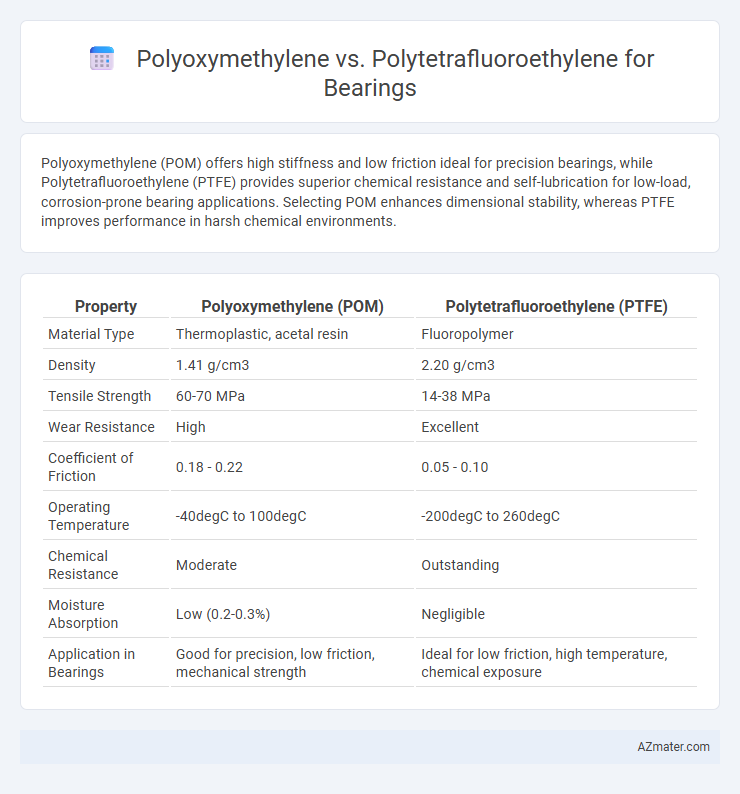Polyoxymethylene (POM) offers high stiffness and low friction ideal for precision bearings, while Polytetrafluoroethylene (PTFE) provides superior chemical resistance and self-lubrication for low-load, corrosion-prone bearing applications. Selecting POM enhances dimensional stability, whereas PTFE improves performance in harsh chemical environments.
Table of Comparison
| Property | Polyoxymethylene (POM) | Polytetrafluoroethylene (PTFE) |
|---|---|---|
| Material Type | Thermoplastic, acetal resin | Fluoropolymer |
| Density | 1.41 g/cm3 | 2.20 g/cm3 |
| Tensile Strength | 60-70 MPa | 14-38 MPa |
| Wear Resistance | High | Excellent |
| Coefficient of Friction | 0.18 - 0.22 | 0.05 - 0.10 |
| Operating Temperature | -40degC to 100degC | -200degC to 260degC |
| Chemical Resistance | Moderate | Outstanding |
| Moisture Absorption | Low (0.2-0.3%) | Negligible |
| Application in Bearings | Good for precision, low friction, mechanical strength | Ideal for low friction, high temperature, chemical exposure |
Introduction to Engineering Plastics in Bearings
Polyoxymethylene (POM) and Polytetrafluoroethylene (PTFE) are critical engineering plastics used in bearing applications due to their unique mechanical and chemical properties. POM offers high stiffness, low friction, and excellent dimensional stability, making it suitable for precision components in automotive and industrial bearings. PTFE provides exceptional chemical resistance and low friction coefficients, ideal for bearings operating in corrosive environments or requiring self-lubrication without maintenance.
Polyoxymethylene (POM) Overview: Properties and Uses
Polyoxymethylene (POM), also known as acetal, is a high-strength, low-friction engineering thermoplastic ideal for bearing applications due to its excellent dimensional stability, wear resistance, and low moisture absorption. Its superior mechanical properties, including high rigidity and hardness combined with good chemical resistance, make POM suitable for precision parts and components subjected to continuous stress and friction. Compared to Polytetrafluoroethylene (PTFE), POM offers greater load-bearing capacity and structural strength, making it preferable for demanding bearing environments requiring durability and precision.
Polytetrafluoroethylene (PTFE) Overview: Properties and Uses
Polytetrafluoroethylene (PTFE) is a high-performance fluoropolymer known for its exceptional chemical resistance, low coefficient of friction, and excellent thermal stability, making it ideal for bearing applications in harsh environments. Its non-reactive nature and low surface energy enable smooth operation and reduced wear in bearings subjected to aggressive chemicals and wide temperature ranges, outperforming Polyoxymethylene (POM) in many industrial settings. PTFE bearings are extensively used in chemical processing, food machinery, and aerospace industries due to their durability, self-lubricating properties, and resistance to corrosion and high temperatures up to 260degC.
Mechanical Strength Comparison: POM vs PTFE
Polyoxymethylene (POM) bearings exhibit superior mechanical strength compared to Polytetrafluoroethylene (PTFE), with higher tensile strength and rigidity, making POM ideal for high-load applications. POM offers a tensile strength of approximately 60-70 MPa, whereas PTFE typically ranges around 20-30 MPa, reflecting its softer, more flexible nature. The enhanced stiffness and wear resistance of POM contribute to prolonged bearing life under mechanical stress, while PTFE's lower strength limits its use to low-load or chemically sensitive environments.
Friction and Wear Performance in Bearings
Polyoxymethylene (POM) exhibits low friction coefficients and good wear resistance, making it suitable for bearing applications requiring smooth operation and durability under moderate loads. Polytetrafluoroethylene (PTFE) offers superior friction reduction due to its self-lubricating properties, delivering excellent performance in low-load, high-speed bearing environments with minimal wear. Comparing both, PTFE outperforms POM in reducing friction, while POM provides better structural strength and wear resistance in more demanding bearing conditions.
Chemical Resistance: POM vs PTFE
Polytetrafluoroethylene (PTFE) offers superior chemical resistance compared to Polyoxymethylene (POM), excelling in environments with aggressive solvents, acids, and bases. POM, while mechanically robust, is more susceptible to chemical degradation when exposed to strong oxidizing agents and hydrocarbons. PTFE's inert molecular structure ensures long-term durability in corrosive applications, making it the preferred choice for bearings operating in chemically harsh conditions.
Temperature Resistance and Stability
Polyoxymethylene (POM) offers excellent dimensional stability and mechanical strength at temperatures up to 100degC, making it suitable for bearings in moderate thermal environments. Polytetrafluoroethylene (PTFE) excels in high-temperature resistance, with stability and performance maintained up to 260degC, ideal for applications requiring chemical inertness and low friction under heat. PTFE's superior thermal stability and self-lubricating properties ensure reliable bearing performance in extreme temperature conditions compared to POM.
Cost Analysis: POM vs PTFE for Bearing Applications
Polyoxymethylene (POM) bearings generally offer a cost-effective solution compared to Polytetrafluoroethylene (PTFE) due to lower raw material prices and easier manufacturing processes. While PTFE provides superior chemical resistance and a lower coefficient of friction, its higher production costs and specialized processing requirements contribute to a significantly increased overall expense in bearing applications. Selecting POM over PTFE can result in substantial cost savings, particularly for high-volume bearing components where performance demands align with POM's mechanical properties.
Typical Bearing Applications: Selecting the Right Material
Polyoxymethylene (POM) bearings excel in precision applications requiring low friction and high dimensional stability, making them ideal for automotive, consumer electronics, and office equipment. Polytetrafluoroethylene (PTFE) bearings provide superior chemical resistance and self-lubricating properties, preferred in corrosive, high-temperature, and hygienic environments like chemical processing and food machinery. Choosing POM or PTFE depends on operational demands such as load, temperature, and environmental exposure to ensure optimal bearing performance and longevity.
Conclusion: Choosing Between Polyoxymethylene and Polytetrafluoroethylene
Polyoxymethylene (POM) offers high stiffness, excellent dimensional stability, and low friction, making it ideal for precise, load-bearing applications requiring durability. Polytetrafluoroethylene (PTFE) provides superior chemical resistance, minimal friction coefficients, and exceptional temperature stability, suited for environments with aggressive chemicals or extreme temperatures. Selecting between POM and PTFE for bearings depends on specific operational demands such as load capacity, chemical exposure, and thermal conditions, with POM preferred for mechanical strength and PTFE for chemical inertness and wide temperature range.

Infographic: Polyoxymethylene vs Polytetrafluoroethylene for Bearing
 azmater.com
azmater.com